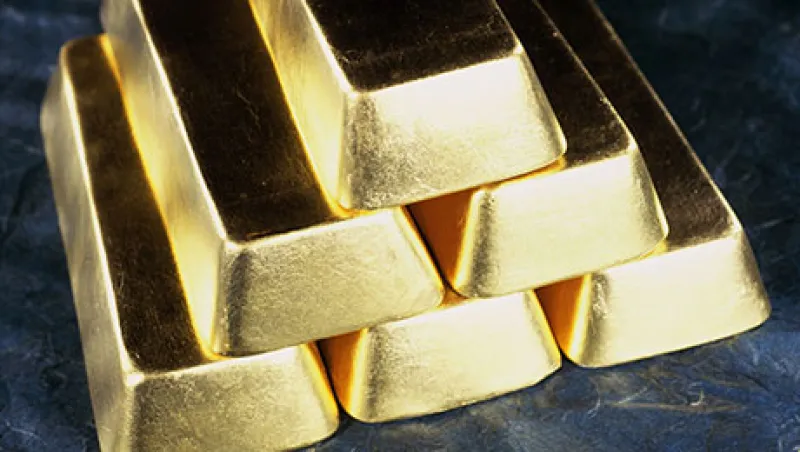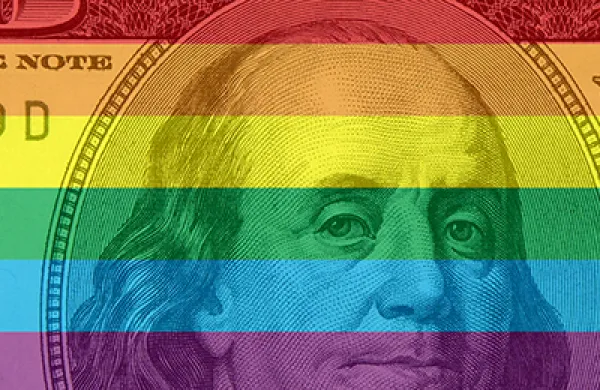The conventional wisdom on gold, from a financial standpoint, is that it has an inverse relationship with the U.S. dollar. When the greenback strengthens, the price of the yellow metal usually goes down as global investors take a flight to investment safety. Yet during the dollar’s recent burst of strength, gold has remained resilient.
“Gold these days is like your highest-quality bond, such as a Treasury,” says Nicholas Johnson, an executive vice president and a portfolio manager focusing on commodities at Pacific Investment Management Co.’s headquarters in Newport Beach, California. “It’s a lot like a 30-year bond with embedded protection to it, very sensitive to the rate of inflation.”
In fact, a primary reason for the disruption in this normal equilibrium is zero-interest-rate policies from the central banks. Trepidation over interest rates — and, by extension, inflation — is depressing gold. When bond yields go up, there’s less reason to hold gold, since the opportunity cost of retaining the metal rises as well. Effectively, when it comes to gold, investor sentiment doesn’t just factor into the equation, it’s a thumb on the scale.
At face value, gold appears to be nothing more than an ultrasafe placeholder.
Its price has held steady since the end of the recession in the U.S.: The price of an ounce of gold has not dropped below the $1,000 mark since September 8, 2009. Since the start of 2015, roughly the time frame for the dollar’s rise against the euro, gold has ranged between $1,149 and $1,302 an ounce, compared with the roughly $420 it fetched in May 2005, when the economy was on an upswing.
As PIMCO’s Johnson pointed out in a January note, the price of gold actually had begun to fall during the second half of 2008 as real yields started to rise. When adjusting for real yield, the price of gold now is effectively at levels seen before the 2008–’09 financial crisis, despite the nominal, actual price having gone up by 50 percent since then. “This suggests that any premium in gold prices following the credit crisis relating to investor risk aversion has now been removed,” Johnson wrote.
Granted, the world’s biggest consumers of gold lie outside ZIRP, or zero-interest-rate policy, economies. Most U.S. and European exposure to gold is in exchange-traded funds, which have seen outflows in recent quarters. The world’s two largest consumers are India and China, countries in which gold remains a traditional store of family wealth. In March Chinese gold imports from Hong Kong hit a seven-year low, according to data from the Hong Kong Census and Statistics Department released April 28. As for India, sellers are banking on jewelry to keep up gold consumption, which dropped 14 percent last year, to 847.7 metric tons from 974.8 metric tons in 2013, according to numbers from the World Gold Council, although sales doubled during peak demand periods.
Demand from emerging markets overall is down as well. For one thing, gold isn’t exactly cheap, especially for buyers using emerging-markets currencies to try to snap up some of the U.S.-dollar denominated commodity.
Wearable gold — an investment often imbued with hard-to-value sentimentality — is trending, at least for the time being. India’s population last year bought the most gold jewelry it has since 1995. Much of this is cultural. “For Indian people in general, gold, along with real estate, is a very traditional investment,” says Harish Sundaresh, vice president, portfolio manager and commodity strategist at Loomis, Sayles & Co. in Boston. From Greece to China, gold is the traditional, if not the only acceptable, wedding gift. In India attendees and well-wishers adorn the bride with so many gold bangles and gold coins that she often emerges from the reception dressed like 1980s television star Mr. T. The intent is that the new couple will use the gold as a nest egg, cashing it in when the time comes for a major purchase or during a financial rough patch.
Cultural shifts are starting to take effect at the margin too.
As part of the structural economic and financial reforms instituted under the administration of India’s prime minister, Narendra Modi, there have been efforts to reduce the use of gold as the primary savings vehicle. Part of this initiative is establishing access to savings and checking accounts for rural and poor segments of Indian society. Look for capital markets to eventually figure into India’s investment options in the coming decades, says Sundaresh. “Such a change would happen slowly over generations, mind you, but within the next 20 years, urbanization and a move toward capitalism will inspire a shift.” Presently, he points out, there is no concept of individual retirement accounts, pensions or a safety net — beyond the family gold.
Follow Anne Szustek on Twitter at @the59thStBridge .
Get more on emerging markets , exchange-traded funds and wealth management .






